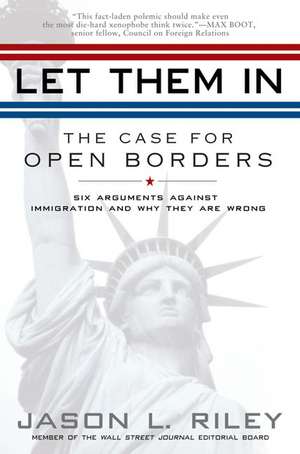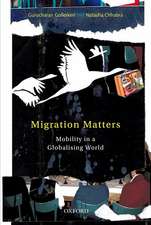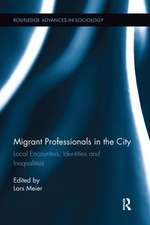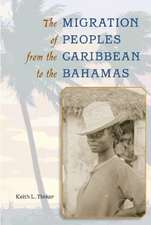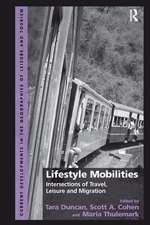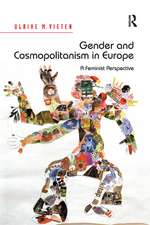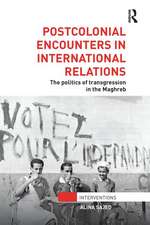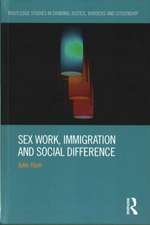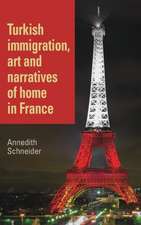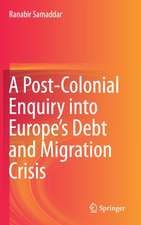Let Them in: The Case for Open Borders
Autor Jason L. Rileyen Limba Engleză Paperback – 31 dec 2008 – vârsta de la 18 ani
A conservative columnist makes an eye-opening case for why immigration improves the lives of Americans and is important for the future of the country
Separating fact from myth in today’s heated immigration debate, a member of The Wall Street Journal editorial board contends that foreign workers play a vital role in keeping America prosperous, that maintaining an open-border policy is consistent with free-market economic principals, and that the arguments put forward by opponents of immigration ultimately don’t hold up to scrutiny.
In lucid, jargon-free prose aimed at the general-interest reader, Riley takes on the most common anti-immigrant complaints, including claims that today’s immigrants overpopulate the United States, steal jobs, depress wages, don’t assimilate, and pose an undue threat to homeland security. As the 2008 presidential election approaches with immigration reform on the front burner, Let Them In is essential reading for liberals and conservatives alike who want to bring an informed perspective to the discussion.
Separating fact from myth in today’s heated immigration debate, a member of The Wall Street Journal editorial board contends that foreign workers play a vital role in keeping America prosperous, that maintaining an open-border policy is consistent with free-market economic principals, and that the arguments put forward by opponents of immigration ultimately don’t hold up to scrutiny.
In lucid, jargon-free prose aimed at the general-interest reader, Riley takes on the most common anti-immigrant complaints, including claims that today’s immigrants overpopulate the United States, steal jobs, depress wages, don’t assimilate, and pose an undue threat to homeland security. As the 2008 presidential election approaches with immigration reform on the front burner, Let Them In is essential reading for liberals and conservatives alike who want to bring an informed perspective to the discussion.
Preț: 131.34 lei
Nou
Puncte Express: 197
Preț estimativ în valută:
25.13€ • 27.29$ • 21.11£
25.13€ • 27.29$ • 21.11£
Carte disponibilă
Livrare economică 01-15 aprilie
Preluare comenzi: 021 569.72.76
Specificații
ISBN-13: 9781592404315
ISBN-10: 1592404316
Pagini: 244
Dimensiuni: 136 x 203 x 18 mm
Greutate: 0.22 kg
Editura: GOTHAM BOOKS
ISBN-10: 1592404316
Pagini: 244
Dimensiuni: 136 x 203 x 18 mm
Greutate: 0.22 kg
Editura: GOTHAM BOOKS
Notă biografică
Jason L. Riley is a member of the editorial board at the Wall Street Journal, where he has worked since 1994. He appears regularly on the Journal Editorial Report on Fox News. He has also appeared on The NewsHour with Jim Lehrer, Hannity and Colmes and ABC’s World News Tonight. He lives in suburban New York City with his wife and daughter.
Extras
Introduction
The magazines and the illustrators are long gone and largely forgotten, but the images endure. Like the 1903 print from Judge, a popular political magazine of the period. It's titled, “The Immigrant: Is he an Acquisition or a Detriment?” and depicts a hulking, exhausted new arrival to America's shores. He wears ragged clothing and lumbers inland with his wife, all their possessions in tow. As human cargo ships sail to and fro in the distance, a small mob greets the man, each individual representing a voice in the raucous turn-of-the-century debate. A contractor says, “He gives me cheap labor.” A workman says, “He cheapens my labor.” A health officer says, “He brings disease.” A citizen calls him “a menace.” A politician says, “He makes votes for me.” Silently determined, the man stares straight ahead, ignoring them all.
Sound familiar?
The targets have changed in the past century, but the concerns have not. Today, we're still being told that when immigrants aren't busy depressing wages; displacing workers; and overrunning our schools, hospitals, and jails, they're compromising our national security. But attacks that were once directed at Asians and Europeans—along with Catholics and Jews—are now directed primarily at Mexicans and other Latin Americans who in recent decades have comprised the bulk of newcomers. Steve King, a congressman from Iowa, compares Mexican aliens to livestock. Tom Tancredo, a Colorado congressman who sports T-shirts announcing that AMERICA IS FULL, says Hispanic immigrants have turned Miami into “a Third World country.” And Don Goldwater, nephew of conservative icon Barry Goldwater and an unsuccessful candidate for governor of Arizona, has called for interring illegal immigrants in concentration camps and pressed them into forced labor building a wall across the southern U.S. border.
Playing on post 9/11 fears, political candidates in California have distributed flyers depicting Mexican immigrants as turbaned Islamic terrorists. Volunteer border patrol groups like the Minuteman Project insist that migrants sneaking across the Sonoran desert aren't just coming here to work and feed their families but also to “reconquer” the Southwest. And despite the fact that, relative to natives, the undocumented are more likely to have jobs and less likely to engage in crime, Newt Gingrich maintains that “young Americans in our cities are [being] massacred” by illegal aliens and says the “war here at home” against these immigrants is “even more deadly than the war in Iraq and Afghanistan.”
Cable news personalities like Lou Dobbs tell us that Salvadorans, Guatemalans, and other Latino migrants bear infectious diseases that imperil U.S. citizens and leave our health-care system teetering on bankruptcy. Talk radio hosts like Michael Savage have urged Americans to protest the presence of Latinos by burning the Mexican flag. J.D. Hayworth, a former Arizona congressman who became a talk radio host after losing his seat in 2006, says we should give America's estimated 12 million undocumented residents—half of whom have been here for more than five years and many of whom have married American citizens and borne American children—120 days to leave the country voluntarily and then deport the remainders by force. Mike Huckabee, a 2008 Republican presidential hopeful and former governor of Arkansas, adopted Haworth's idea as part of his official campaign platform. Huckabee's reward was an endorsement from Jim Gilchrist, the founder of the Minuteman Project.
Nativists warn that the brown influx from Mexico is soiling our Anglo-American cultural fabric, damaging our social mores, and facilitating a U.S. identity crisis. Anti-immigrant screeds with hysterical titles like Invasion by Michelle Malkin and State of Emergency by Pat Buchanan have become best-sellers. Tomes by serious academics like Samuel Huntington and Victor Davis Hanson make the same arguments using bigger words and giving the cruder polemicists some intellectual cover.
And then there's the odd bed-sharing. Liberal columnists like Nicholas Kristof of The New York Times and conservative policy analysts like Robert Rector of The Heritage Foundation both fret that immigration from Mexico merely swells the ranks of the U.S. poor and burdens our social services. Republicans convinced that Mexican immigrants are natural Democrats find common cause with both the economic protectionists, who say immigrants crib jobs, and the population-control environmentalists, who want the border sealed on grounds that the United States already has too many people.
All of them, however, arrive at the same pessimistic conclusion, which is that immigration on balance is a net negative for the United States. They go to great lengths to demonstrate that today's new arrivals are different from yesterday's, uniquely incapable of assimilation. They cite special circumstances that made the past acculturation of European and Asian immigration possible but render it impossible for Latinos. They view these foreigners as a liability rather than an asset. The want an immigrant “time-out.”
What Would Reagan Do?
If you're a free market conservative in the Ronald Reagan tradition, this debate has been doubly depressing because so much of the bellyaching has originated with the political right, where many people have convinced themselves that scapegoating immigrants for America's economic and social ills—real and imagined—is a winner at the polls. On the topic of immigration, at least, too many conservatives have pocketed their principles and morphed into reactionary Populists. They claim to be Reaganites, but temperamentally and rhetorically that have more in common with Pat Buchanan, if not Father Coughlin. Their right-wing version of the “angry left” promotes a politics of resentment, frustration, and fear. It stirs up isolationism and xenophobia. And as a political strategy it's heretofore been a loser, just like Buchanan for his presidential bids.
Besides, the nativist noise that has saturated so much of talk radio, cable news, and conservative print journalism in recent years is about as far from the Gipper's style as you can get. To Reagan, ever the optimist, America was “a shining city upon a Hill,” in the John Winthrop phrase he liked to use. Liberal immigration policies were proof that this country remained a land of opportunity, a nation built on the idea of liberty, not the Blut und Boden European doctrine.
Reagan held this view long before he became president, as Lou Cannon, his biographer, had documented. In 1952, when the United States was still under the thumb of highly restrictive immigration quotes enacted in the 1920s, Reagan gave a speech endorsing open borders. In his view, America was “the promised land” for people from “any place in the world.” Reagan said “any person with the courage, the desire to tear up their roots, to strive for freedom, to attempt and dare to live in a strange land and foreign place, to travel halfway across the world was welcome here.”
p>In a 1977 radio address, Reagan discussed what he called “the illegal alien fuss. Are great numbers of our unemployed really victims of the illegal alien invasion, or are those illegal tourists actually doing work our own people won't do? One thing is certain in this hungry world: No regulation or law should be allowed if it results in crops rotting in the fields for lack of harvesters.” The next time you tune into Rush Limbaugh, Sean Hannity, Laura Ingraham, Hugh Hewitt, and Dennis Prager, contrast their take immigration with radio Reagan's.Reagan understood that immigrants are coming here to work, no live on the dole. He also grasped that natives and immigrants don't compete with one another for jobs in a zero-sum labor market and that our policy makers would do better to focus less on protecting U.S. workers from immigrant competition and more on expanding the economic pie. In his November 1979 speech announcing his candidacy for president, Reagan called for free labor flows throughout North America. Reagan knew that immigration, like free trade, which he also supported, benefits everyone in the long run.
Later in the campaign, in December of 1979, Reagan responded to criticism from conservative columnist Holmes Alexander. “Please believe me when I tell you the idea of a North American accord has been mine for many, many years,” said the future president. And conservatives calling today for a well along the entire United States-Mexico border should know that Reagan was not a big fan of that prospect. “Some months before I declared,” he continued in his response to Alexander, “I asked for a meeting and crossed the border to meet with the president of Mexico…I went, as I said in my announcement address, to ask him his ideas—how we could make the border something other than a locale for a nine-foot fence.”
At the end of his presidency, Reagan was still invoking Winthrop. “I've spoken of the shining city all my political life, but I don't know if I ever quite communicated what I saw when I said it,” he remarked in his 1989 farewell address to the nation. “But in my mind it was a tall proud city built on rocks stronger than oceans, wind-swept, God-blessed, and teeming with people of all kinds living in harmony and peace, a city with free ports that hummed with commerce and creativity, and if they had to be city walls, the walls had doors and the doors were open to anyone with the will and the heart to get here.”
It's true that in 1986 Reagan signed the Immigration Control and Reform Act, which included employer sanctions and more border security, but he also insisted on a provision for legalizing immigrants already in the United States. Which is to say, he supported “amnesty.” In his signing statement, he said, “We have consistently supported a legalization program which is both generous to the alien and fair to the countless thousands of people throughout the world who seek legally to come to America. The legalization provisions in this act will go far to improve the lives of a class of individuals who must now hide in the shadows, without access to many of the benefits of a free and open society. Very soon many of these men and women will be able to step into the sunlight, and, ultimately, if they choose, they may become Americans.”
Same Old, Same Old
Most every anti-immigrant argument rolled out today is a retread. Benjamin Franklin was complaining about bilingual sign posts and “swarms” of inassimilable Germans migrating to Pennsylvania 250 years ago. Later, in the nineteenth century, people like Samuel Morse, inventor of the telegraph and a leading nativist in his day, would pick up Franklin's banner. Morse was a founder and generous financier of the anti-immigrant and anti-Catholic Know-Nothing movement, and in lieu of Germans he railed against Irish immigration in the antebellum decades. In his 1835 treatise against the political influence of Catholicism, Morse argued that poor, uneducated Irish Catholics were subverting the values and ideals of Anglo-America and should therefore be kept out of the country.
Opposition to Asian immigration came next. By the later part of the nineteenth century, “Yellow Peril” was all the rage, stoked by increased Chinese migration to the American-West. A famous 1881 illustration first published in The Wasp, a San Franciscan-based literary magazine edited by Ambrose Bierce, depicts Lady Liberty as a Chinese coolie gripping an opium pipe. The rays of light emanating from the statue's head are labeled “Immorality,” “Filth,” “Disease,” and “Ruin to White Labor.”
Henry George, who would later become an influential political economist, first gained prominence denouncing what he called the “Mongolization of America.” In 1881, George wrote of “the supreme law of self-preservation which justifies us in shutting out a non-assimilable element fraught for us with great social and political dangers.” He warned that Asians “will introduce into the life of the republic race prejudices and social bitterness.” He said they would “reduce wages and degrade labor, and widen the gulf between rich and poor.” And like today's nativists, George was concerned that “the Chinese, if free play be allowed their immigration, [will] supplant the white race.”
Slouching Toward Guatemala?
Modern-day restrictionists either don't know this history or are hoping the public doesn't know it. But what's most relevant about these time-honored arguments is that those spouting them have a perfect record of being wrong. Immigration alarmism sells books and boosts TV and radio ratings, but its doomsday scenarios never seem to come to fruition.
Elite thinkers today continue to insist that U.S. culture is slouching toward Guatemala. In his 2004 book Who Are We? Harvard political scientist Samuel Huntington writes that “contemporary immigration is unprecedented in American history” and that “the experience and lessons of past immigration have little relevance to understanding its dynamics and consequences.” As far as Huntington is concerned, the historical record should have little bearing on immigration public policy decisions going forward. Curious notion, that.
The immigration issue is the fool's gold of American politics. Voters like to sound off to pollsters about it, yet they inevitably pull the lever on Election Day with other matters foremost in mind. Elections seldom if ever turn on immigration, and the GOP restrictionist message so adored by talk radio, cable news, and the blogosphere once again failed to deliver the goods in 2006, when the Republicans lost control of the House and Senate.
Worse, the GOP had made “securing the border” a loud national theme in the run-up to the 2006 election, only to do nothing about it save for approving for a few hundred miles of fence along a two-thousand-mile border. Republicans thus managed to highlight either their fecklessness in failing to do something about an allegedly urgent problem or their cynicism in raising the issue at all.
The GOP has a long history of fumbling immigration. And President George W. Bush, a former border-state governor who knows the issue well, has tried to steer conservatism and Republicanism away from repeating those mistakes with Hispanics, who are the country's fastest-growing voting bloc. Mr. Bush doesn't want his party to lose Latinos the way its xenophobic message in the early twentieth century turned away Irish, Italian, and Asian voters for decades.
But this isn't just about identity politics, which conservatives by and large are happy to leave to the political left. Like Reagan before him, Bush understands that immigrants help the United States stay atop the global marketplace. A liberal immigration policy has served the country quite well over the past two centuries, and the numbers coming today are hardly extraordinary. Since the government began keep count in 1820, the United States has absorbed a world-leading 60 million immigrants from some 170 nations. The latest census data puts our foreign-born population at 33.5 million, which is roughly the population of Canada. In terms of absolute numbers, that's a record. But as a percentage of the total U.S. population, it's still well below the historic highs reached in 1890 and 1910.
Immigrants prefer America because it remains the world's foremost tribune to freedom and opportunity. Its magnetism is a testament to the country's global standing. Even better, it's an indication that America is still winning the international battle for talent and human capital that will keep it competitive for generations to come.
Richer and Safer
This book expounds on two general themes. The first is that, contrary to received wisdom, today's Latino immigrants aren't “different”, just newer. The second is that an open immigration policy is compatible with free-market conservatism and homeland security. I explain, from a conservative perspective, why the pessimists who say otherwise are mistaken. I argue that immigrants, including low-skill immigrants, are an asset to the United States, not a liability. Immigrants help keep our workforce younger and stronger than Asia's and Europe's. As entrepreneurs, they create jobs. As consumers, they generate economic growth. By taking jobs that overqualified Americans spurn, they fill niches in the workforce that make our economy more efficient and allow for the upward mobility of the native population.
An immigration policy that acknowledges these economic realities would provide more, not fewer, legal ways for immigrants to enter the country. That, in turn, would go a long way toward reducing illegal entries. It would also alleviate pressure on the border and free up our overburdened patrols to track down terrorists, drug dealers, and other serious threats to our welfare. Unfortunately, as things stand, our border security officers spend most of their time chasing migrants who come north to mow our lawns and burp our babies. A guest-worker program for such individuals would help regulate the labor flow and isolate the criminals, thus making us much safer than any wall along the Rio Grande.
The magazines and the illustrators are long gone and largely forgotten, but the images endure. Like the 1903 print from Judge, a popular political magazine of the period. It's titled, “The Immigrant: Is he an Acquisition or a Detriment?” and depicts a hulking, exhausted new arrival to America's shores. He wears ragged clothing and lumbers inland with his wife, all their possessions in tow. As human cargo ships sail to and fro in the distance, a small mob greets the man, each individual representing a voice in the raucous turn-of-the-century debate. A contractor says, “He gives me cheap labor.” A workman says, “He cheapens my labor.” A health officer says, “He brings disease.” A citizen calls him “a menace.” A politician says, “He makes votes for me.” Silently determined, the man stares straight ahead, ignoring them all.
Sound familiar?
The targets have changed in the past century, but the concerns have not. Today, we're still being told that when immigrants aren't busy depressing wages; displacing workers; and overrunning our schools, hospitals, and jails, they're compromising our national security. But attacks that were once directed at Asians and Europeans—along with Catholics and Jews—are now directed primarily at Mexicans and other Latin Americans who in recent decades have comprised the bulk of newcomers. Steve King, a congressman from Iowa, compares Mexican aliens to livestock. Tom Tancredo, a Colorado congressman who sports T-shirts announcing that AMERICA IS FULL, says Hispanic immigrants have turned Miami into “a Third World country.” And Don Goldwater, nephew of conservative icon Barry Goldwater and an unsuccessful candidate for governor of Arizona, has called for interring illegal immigrants in concentration camps and pressed them into forced labor building a wall across the southern U.S. border.
Playing on post 9/11 fears, political candidates in California have distributed flyers depicting Mexican immigrants as turbaned Islamic terrorists. Volunteer border patrol groups like the Minuteman Project insist that migrants sneaking across the Sonoran desert aren't just coming here to work and feed their families but also to “reconquer” the Southwest. And despite the fact that, relative to natives, the undocumented are more likely to have jobs and less likely to engage in crime, Newt Gingrich maintains that “young Americans in our cities are [being] massacred” by illegal aliens and says the “war here at home” against these immigrants is “even more deadly than the war in Iraq and Afghanistan.”
Cable news personalities like Lou Dobbs tell us that Salvadorans, Guatemalans, and other Latino migrants bear infectious diseases that imperil U.S. citizens and leave our health-care system teetering on bankruptcy. Talk radio hosts like Michael Savage have urged Americans to protest the presence of Latinos by burning the Mexican flag. J.D. Hayworth, a former Arizona congressman who became a talk radio host after losing his seat in 2006, says we should give America's estimated 12 million undocumented residents—half of whom have been here for more than five years and many of whom have married American citizens and borne American children—120 days to leave the country voluntarily and then deport the remainders by force. Mike Huckabee, a 2008 Republican presidential hopeful and former governor of Arkansas, adopted Haworth's idea as part of his official campaign platform. Huckabee's reward was an endorsement from Jim Gilchrist, the founder of the Minuteman Project.
Nativists warn that the brown influx from Mexico is soiling our Anglo-American cultural fabric, damaging our social mores, and facilitating a U.S. identity crisis. Anti-immigrant screeds with hysterical titles like Invasion by Michelle Malkin and State of Emergency by Pat Buchanan have become best-sellers. Tomes by serious academics like Samuel Huntington and Victor Davis Hanson make the same arguments using bigger words and giving the cruder polemicists some intellectual cover.
And then there's the odd bed-sharing. Liberal columnists like Nicholas Kristof of The New York Times and conservative policy analysts like Robert Rector of The Heritage Foundation both fret that immigration from Mexico merely swells the ranks of the U.S. poor and burdens our social services. Republicans convinced that Mexican immigrants are natural Democrats find common cause with both the economic protectionists, who say immigrants crib jobs, and the population-control environmentalists, who want the border sealed on grounds that the United States already has too many people.
All of them, however, arrive at the same pessimistic conclusion, which is that immigration on balance is a net negative for the United States. They go to great lengths to demonstrate that today's new arrivals are different from yesterday's, uniquely incapable of assimilation. They cite special circumstances that made the past acculturation of European and Asian immigration possible but render it impossible for Latinos. They view these foreigners as a liability rather than an asset. The want an immigrant “time-out.”
What Would Reagan Do?
If you're a free market conservative in the Ronald Reagan tradition, this debate has been doubly depressing because so much of the bellyaching has originated with the political right, where many people have convinced themselves that scapegoating immigrants for America's economic and social ills—real and imagined—is a winner at the polls. On the topic of immigration, at least, too many conservatives have pocketed their principles and morphed into reactionary Populists. They claim to be Reaganites, but temperamentally and rhetorically that have more in common with Pat Buchanan, if not Father Coughlin. Their right-wing version of the “angry left” promotes a politics of resentment, frustration, and fear. It stirs up isolationism and xenophobia. And as a political strategy it's heretofore been a loser, just like Buchanan for his presidential bids.
Besides, the nativist noise that has saturated so much of talk radio, cable news, and conservative print journalism in recent years is about as far from the Gipper's style as you can get. To Reagan, ever the optimist, America was “a shining city upon a Hill,” in the John Winthrop phrase he liked to use. Liberal immigration policies were proof that this country remained a land of opportunity, a nation built on the idea of liberty, not the Blut und Boden European doctrine.
Reagan held this view long before he became president, as Lou Cannon, his biographer, had documented. In 1952, when the United States was still under the thumb of highly restrictive immigration quotes enacted in the 1920s, Reagan gave a speech endorsing open borders. In his view, America was “the promised land” for people from “any place in the world.” Reagan said “any person with the courage, the desire to tear up their roots, to strive for freedom, to attempt and dare to live in a strange land and foreign place, to travel halfway across the world was welcome here.”
p>In a 1977 radio address, Reagan discussed what he called “the illegal alien fuss. Are great numbers of our unemployed really victims of the illegal alien invasion, or are those illegal tourists actually doing work our own people won't do? One thing is certain in this hungry world: No regulation or law should be allowed if it results in crops rotting in the fields for lack of harvesters.” The next time you tune into Rush Limbaugh, Sean Hannity, Laura Ingraham, Hugh Hewitt, and Dennis Prager, contrast their take immigration with radio Reagan's.Reagan understood that immigrants are coming here to work, no live on the dole. He also grasped that natives and immigrants don't compete with one another for jobs in a zero-sum labor market and that our policy makers would do better to focus less on protecting U.S. workers from immigrant competition and more on expanding the economic pie. In his November 1979 speech announcing his candidacy for president, Reagan called for free labor flows throughout North America. Reagan knew that immigration, like free trade, which he also supported, benefits everyone in the long run.
Later in the campaign, in December of 1979, Reagan responded to criticism from conservative columnist Holmes Alexander. “Please believe me when I tell you the idea of a North American accord has been mine for many, many years,” said the future president. And conservatives calling today for a well along the entire United States-Mexico border should know that Reagan was not a big fan of that prospect. “Some months before I declared,” he continued in his response to Alexander, “I asked for a meeting and crossed the border to meet with the president of Mexico…I went, as I said in my announcement address, to ask him his ideas—how we could make the border something other than a locale for a nine-foot fence.”
At the end of his presidency, Reagan was still invoking Winthrop. “I've spoken of the shining city all my political life, but I don't know if I ever quite communicated what I saw when I said it,” he remarked in his 1989 farewell address to the nation. “But in my mind it was a tall proud city built on rocks stronger than oceans, wind-swept, God-blessed, and teeming with people of all kinds living in harmony and peace, a city with free ports that hummed with commerce and creativity, and if they had to be city walls, the walls had doors and the doors were open to anyone with the will and the heart to get here.”
It's true that in 1986 Reagan signed the Immigration Control and Reform Act, which included employer sanctions and more border security, but he also insisted on a provision for legalizing immigrants already in the United States. Which is to say, he supported “amnesty.” In his signing statement, he said, “We have consistently supported a legalization program which is both generous to the alien and fair to the countless thousands of people throughout the world who seek legally to come to America. The legalization provisions in this act will go far to improve the lives of a class of individuals who must now hide in the shadows, without access to many of the benefits of a free and open society. Very soon many of these men and women will be able to step into the sunlight, and, ultimately, if they choose, they may become Americans.”
Same Old, Same Old
Most every anti-immigrant argument rolled out today is a retread. Benjamin Franklin was complaining about bilingual sign posts and “swarms” of inassimilable Germans migrating to Pennsylvania 250 years ago. Later, in the nineteenth century, people like Samuel Morse, inventor of the telegraph and a leading nativist in his day, would pick up Franklin's banner. Morse was a founder and generous financier of the anti-immigrant and anti-Catholic Know-Nothing movement, and in lieu of Germans he railed against Irish immigration in the antebellum decades. In his 1835 treatise against the political influence of Catholicism, Morse argued that poor, uneducated Irish Catholics were subverting the values and ideals of Anglo-America and should therefore be kept out of the country.
Opposition to Asian immigration came next. By the later part of the nineteenth century, “Yellow Peril” was all the rage, stoked by increased Chinese migration to the American-West. A famous 1881 illustration first published in The Wasp, a San Franciscan-based literary magazine edited by Ambrose Bierce, depicts Lady Liberty as a Chinese coolie gripping an opium pipe. The rays of light emanating from the statue's head are labeled “Immorality,” “Filth,” “Disease,” and “Ruin to White Labor.”
Henry George, who would later become an influential political economist, first gained prominence denouncing what he called the “Mongolization of America.” In 1881, George wrote of “the supreme law of self-preservation which justifies us in shutting out a non-assimilable element fraught for us with great social and political dangers.” He warned that Asians “will introduce into the life of the republic race prejudices and social bitterness.” He said they would “reduce wages and degrade labor, and widen the gulf between rich and poor.” And like today's nativists, George was concerned that “the Chinese, if free play be allowed their immigration, [will] supplant the white race.”
Slouching Toward Guatemala?
Modern-day restrictionists either don't know this history or are hoping the public doesn't know it. But what's most relevant about these time-honored arguments is that those spouting them have a perfect record of being wrong. Immigration alarmism sells books and boosts TV and radio ratings, but its doomsday scenarios never seem to come to fruition.
Elite thinkers today continue to insist that U.S. culture is slouching toward Guatemala. In his 2004 book Who Are We? Harvard political scientist Samuel Huntington writes that “contemporary immigration is unprecedented in American history” and that “the experience and lessons of past immigration have little relevance to understanding its dynamics and consequences.” As far as Huntington is concerned, the historical record should have little bearing on immigration public policy decisions going forward. Curious notion, that.
The immigration issue is the fool's gold of American politics. Voters like to sound off to pollsters about it, yet they inevitably pull the lever on Election Day with other matters foremost in mind. Elections seldom if ever turn on immigration, and the GOP restrictionist message so adored by talk radio, cable news, and the blogosphere once again failed to deliver the goods in 2006, when the Republicans lost control of the House and Senate.
Worse, the GOP had made “securing the border” a loud national theme in the run-up to the 2006 election, only to do nothing about it save for approving for a few hundred miles of fence along a two-thousand-mile border. Republicans thus managed to highlight either their fecklessness in failing to do something about an allegedly urgent problem or their cynicism in raising the issue at all.
The GOP has a long history of fumbling immigration. And President George W. Bush, a former border-state governor who knows the issue well, has tried to steer conservatism and Republicanism away from repeating those mistakes with Hispanics, who are the country's fastest-growing voting bloc. Mr. Bush doesn't want his party to lose Latinos the way its xenophobic message in the early twentieth century turned away Irish, Italian, and Asian voters for decades.
But this isn't just about identity politics, which conservatives by and large are happy to leave to the political left. Like Reagan before him, Bush understands that immigrants help the United States stay atop the global marketplace. A liberal immigration policy has served the country quite well over the past two centuries, and the numbers coming today are hardly extraordinary. Since the government began keep count in 1820, the United States has absorbed a world-leading 60 million immigrants from some 170 nations. The latest census data puts our foreign-born population at 33.5 million, which is roughly the population of Canada. In terms of absolute numbers, that's a record. But as a percentage of the total U.S. population, it's still well below the historic highs reached in 1890 and 1910.
Immigrants prefer America because it remains the world's foremost tribune to freedom and opportunity. Its magnetism is a testament to the country's global standing. Even better, it's an indication that America is still winning the international battle for talent and human capital that will keep it competitive for generations to come.
Richer and Safer
This book expounds on two general themes. The first is that, contrary to received wisdom, today's Latino immigrants aren't “different”, just newer. The second is that an open immigration policy is compatible with free-market conservatism and homeland security. I explain, from a conservative perspective, why the pessimists who say otherwise are mistaken. I argue that immigrants, including low-skill immigrants, are an asset to the United States, not a liability. Immigrants help keep our workforce younger and stronger than Asia's and Europe's. As entrepreneurs, they create jobs. As consumers, they generate economic growth. By taking jobs that overqualified Americans spurn, they fill niches in the workforce that make our economy more efficient and allow for the upward mobility of the native population.
An immigration policy that acknowledges these economic realities would provide more, not fewer, legal ways for immigrants to enter the country. That, in turn, would go a long way toward reducing illegal entries. It would also alleviate pressure on the border and free up our overburdened patrols to track down terrorists, drug dealers, and other serious threats to our welfare. Unfortunately, as things stand, our border security officers spend most of their time chasing migrants who come north to mow our lawns and burp our babies. A guest-worker program for such individuals would help regulate the labor flow and isolate the criminals, thus making us much safer than any wall along the Rio Grande.
Descriere
A conservative columnist makes an eye-opening case for why immigration improves the lives of Americans and is important for the future of the country.
